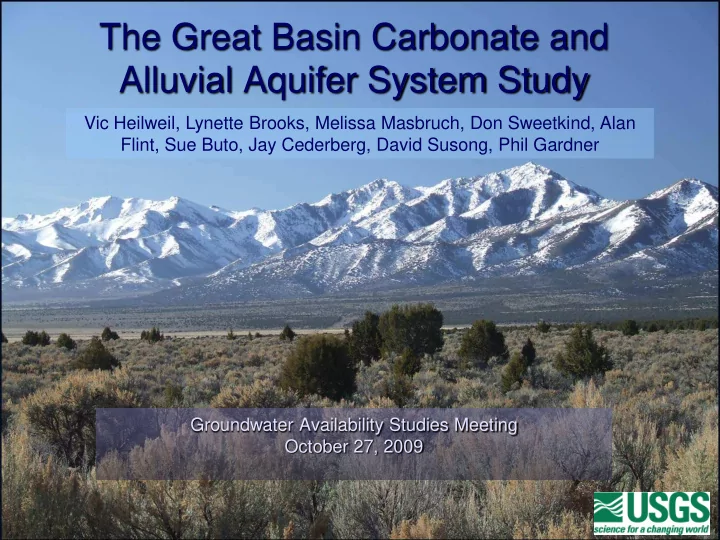

The Great Basin Carbonate and Alluvial Aquifer System Study Vic Heilweil, Lynette Brooks, Melissa Masbruch, Don Sweetkind, Alan Flint, Sue Buto, Jay Cederberg, David Susong, Phil Gardner Groundwater Availability Studies Meeting October 27, 2009
Regional-Scale Approach to National Assessment
GBCAAS Study Area • Large area (over 250,000 km 2 ) -165 hydrographic areas -17 ground-water flow systems -4 western states (CA, ID, NV, UT) • Large elevation gradient (-90 m to 4,300 m)
Mean Annual Precipitation • 50 to 1800 mm/yr • Strong gradient from dry southwest (Death Valley) to wet northeast (northern Wasatch Front) • Most precipitation occurs as winter mountain snowfall
Hydrogeologic Framework • 9 HGU’s • Improved 3-D understanding of GBCAAS study area
GBCAAS Pre- Development Groundwater Budget Total recharge = 4.5 ± 2.2 M acre-ft/yr Total discharge = 4.1 ± 1.2 M acre-ft/yr [all values in millions of acre-ft/yr]
Products: 1. Conceptual Model SIR 2. Numerical Model SIR (Heilweil and Brooks, eds, 2011)
Historical GBCAAS Well Withdrawals Thousands of Acre-Feet Well Withdrawals, In • Rapid increase from the 1940s through the 1970s • Variable pumping of past 3 decades with wet and dry cycles • Even though overall pumping is not increasing, current extraction rates in many areas are not sustainable
Pahrump Valley DEPTH TO GROUNDWATER BELOW LAND SURFACE, IN FEET Las Vegas Valley Some parts of the GBCAAS study area have undergone substantial Salt Lake Valley groundwater declines Beryl-Enterprise Area
Current Groundwater Depletion • Well withdrawals in 2000 for GBCAAS were 1.5 million acre-ft (80% of which came from four flow systems) • GBCAAS is largely undeveloped compared to other regional aquifers such as High Plains • Pumping in some areas has caused declining water levels, decrease in ET and spring discharge, and land subsidence • These few basins should serve as an early warning of the effects of excessive groundwater extraction in the GBCAAS study area
GBCAAS Hydrogeologic Concerns • Limited surface-water resources result in heavy reliance on groundwater and restrict overall water availability • Majority of study area is unpopulated, although populated areas have some of the highest growth rates in the US (Las Vegas, Wasatch Front) Over-extraction in many parts of the study area is causing: • Declining groundwater levels • Land subsidence • Declining spring discharge and ET areas • Ecological impacts, endangered species • Last 50 years have had above-average precipitation, but longer term climate record shows various “mega-droughts”
Future depletion? SNWA to pump 170,000 acre-ft/yr from 6 eastern NV basins Societal issues: water exportation, transfer from agricultural to Spring V. municipal/industrial purposes Snake V. Planned pumping from these HAs represents up to 80% of estimated natural recharge More-detailed ongoing and planned USGS studies in Snake and Deep Greek (Goshute tribe) Valleys in response to local concerns over groundwater development
GBCAAS “Story” • 165 separate HAs separated by complex mountain blocks • Mostly unpopulated, but some very high growth areas • Mostly arid; heavy reliance on groundwater • Trend of transferring water from agriculture to urban use • Pumping is diverting discharge as ET and springflow • Over-extraction in some areas causing declines, subsidence • GBCAAS budget compilation 1 st to “close” the GW budget • Hydrogeol. framework to improve conceptual model • Numerical model for redefining flow systems, future predictions
Assessment of groundwater flow paths, sources of water to springs, and connection of basin-fill and carbonate aquifers in Snake Valley and surrounding basins, Utah and Nevada Phil Gardner , Melissa Masbruch, Victor Heilweil, and David Susong U.S. Geological Survey http://ut.water.usgs.gov/projects/snake
Objectives of Proposed Work To improve the understanding of: • groundwater flow in both basin-fill and carbonate aquifers • connections between the aquifers and between valleys • sources of water to springs and wells in Snake Valley To constrain groundwater budget estimates • specifically, estimates of flow between basins To compile baseline hydrologic data to better quantify current hydrologic conditions in the Snake Valley area • necessary to plan for potential effects of groundwater development on groundwater and surface-water resources
Snake Valley potentiometric map • Groundwater divide in Spring Val. • Barrier to flow along E Snake Val. • Large area of flat water level altitude in west-central Millard Co. • Used to develop the model and to interpret the geochemistry • Concepts of flow are evolving • Dashed contours through the confusion range
Terrigenic 4 He
Noble-gas recharge temperatures • Distinct break in T r • Coolest in southern Snake Range • Warmest in Thule, Fish Springs, and Sevier desert
Snake Valley products & timeline • Scientific Investigation Map – in review, approval by Oct 2011 • Scientific Investigation Report - Summarize baseline hydrologic data - Document synthesis of potentiometric map, hydrogeologic framework, geochemistry, and numerical model to expand on conceptual model of groundwater flow - Document results of numerical model and refinement of budget estimates
Recommend
More recommend